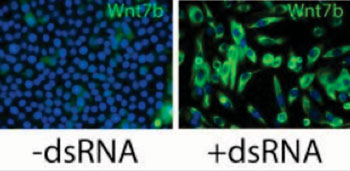Molecular Pathway Leads to Skin and Hair Regeneration After Injury
By LabMedica International staff writers
Posted on 25 Aug 2015
The ability of the skin to regenerate after injury has been linked to stimulation of Toll-Like Receptor 3 (TLR3) by double-stranded RNA (dsRNA) released by the damaged skin.Posted on 25 Aug 2015
Replacement of skin and hair follicles after wounding through a process known as wound-induced hair neogenesis (WIHN) is a rare example of adult organ regeneration in mammals. As such, WIHN provides a unique model system for deciphering mechanisms underlying mammalian regeneration.

Image: Skin cells (keratinocytes) treated with an agent that activates TLR3 (dsRNA) can turn on important regeneration proteins, like Wnt7b (green) (Photo courtesy of Johns Hopkins University).
Investigators at Johns Hopkins University (Baltimore, MD, USA) used mouse models to study skin and hair follicle regeneration. Initially, by comparing normal mice to an inbred strain with restricted ability to regenerate skin, they found that expression of TLR3 was three times higher in the normal animals.
The application of synthetic dsRNA to mouse skin wounds led to a greater number of regenerated follicles. In contrast, treatment with a substance that broke up dsRNA decreased the number of regenerated follicles, and regeneration was nearly abolished in mice deficient in TLR3.
Results published in the August 6, 2015, issue of the journal Cell Stem Cell revealed that the process that began with dsRNA activation of TLR3 continued to hair follicle regeneration through the action of TLR3's downstream effectors IL-6 (interleukin-6) and STAT3 (signal transducer and activator of transcription 3). Loss of TLR3, IL-6Ra, or Stat3 proteins reduced WHIN in mice with damaged skin.
“Our study uncovers a novel role for a protein that works as a master regulator of regeneration in the skin,” said senior author Dr. Luis A. Garza, associate professor of dermatology at Johns Hopkins University. “Medications that turn on this protein have the powerful potential to decrease scarring as healing of wounds takes place, thereby promoting skin and hair follicle regeneration.”
“A lot of human disability is from scarring,” said Dr. Garza. “After a heart attack, we are really good at replacing the blood flow, but it is the scar on the heart afterward that is the real problem. We and others in the field of regenerative medicine are interested in how to enhance or trigger regeneration in such situations.”
Related Links:
Johns Hopkins University














